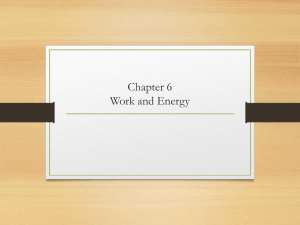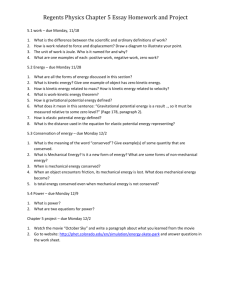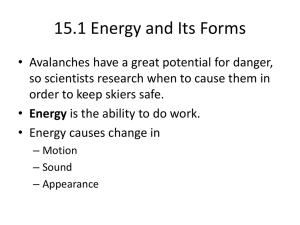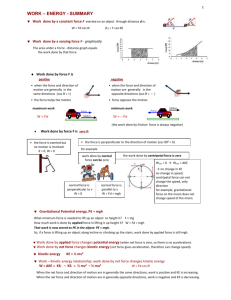Rotational Kinetic Energy
advertisement
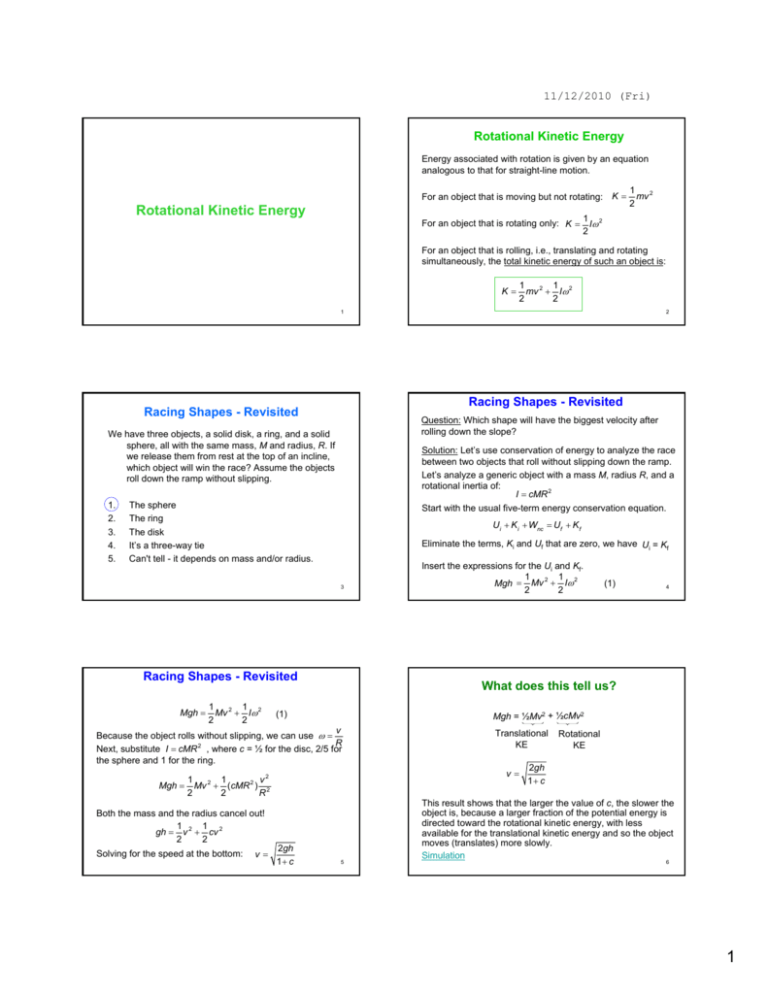
11/12/2010 (Fri) Rotational Kinetic Energy Energy associated with rotation is given by an equation analogous to that for straight-line motion. For an object that is moving but not rotating: K = Rotational Kinetic Energy For an object that is rotating only: K = 1 mv 2 2 1 2 Iω 2 For an object that is rolling, i.e., translating and rotating simultaneously, the total kinetic energy of such an object is: K= 1 1 mv 2 + Iω 2 2 2 1 Racing Shapes - Revisited Racing Shapes - Revisited Question: Which shape will have the biggest velocity after rolling down the slope? We have three objects, a solid disk, a ring, and a solid sphere, all with the same mass, M and radius, R. If we release them from rest at the top of an incline, which object will win the race? Assume the objects roll down the ramp without slipping. 1. 2. 3. 4. 5. Solution: Let’s use conservation of energy to analyze the race between two objects that roll without slipping down the ramp. Let’s analyze a generic object with a mass M, radius R, and a rotational inertia of: I = cMR 2 Start with the usual five-term energy conservation equation. The sphere The ring The disk It’s a three-way tie Can't tell - it depends on mass and/or radius. Ui + K i + Wnc = Uf + K f Eliminate the terms, Ki and Uf that are zero, we have Ui = Kf 3 Racing Shapes - Revisited Mgh = 1 1 Mv 2 + Iω 2 2 2 (1) v= Translational KE v= 2gh 1+ c (1) 4 Mgh = ½Mv2 + ½cMv2 1 1 v2 Mgh = Mv 2 + (cMR 2 ) 2 2 2 R Solving for the speed at the bottom: Insert the expressions for the Ui and Kf. 1 1 2 2 Mgh = Mv + Iω 2 2 What does this tell us? v Because the object rolls without slipping, we can use ω = R Next, substitute I = cMR 2 , where c = ½ for the disc, 2/5 for the sphere and 1 for the ring. Both the mass and the radius cancel out! 1 1 gh = v 2 + cv 2 2 2 2 5 Rotational KE 2gh 1+ c This result shows that the larger the value of c, the slower the object is, because a larger fraction of the potential energy is directed toward the rotational kinetic energy, with less available for the translational kinetic energy and so the object moves (translates) more slowly. Simulation 6 1 A Figure Skater - Revisit A Figure Skater - Revisit A spinning figure skater is an excellent example of angular momentum conservation. The skater starts spinning with her arms outstretched, and has a rotational inertia of Ii and an initial angular velocity of ωi. When she moves her arms close to her body, she spins faster. Her moment of inertia decreases, so her angular velocity must increase to keep the angular momentum constant. Conserving angular momentum: v v Li = Lf Question: When the figure skater moves her arms in closer to her body while she is spinning, what happens to the skater’s rotational kinetic energy? 1. 2. 3. It increases It decreases It must stay the same, because of conservation of energy v v I iωi = I f ω f Question: In this process, what happens to the skater's kinetic energy? 7 A Figure Skater - Revisit Ki = Kf = A ball rolling down a ramp 1 1 I iωi2 = ( I iωi ) × ωi 2 2 ( 8 Question: A ball with mass M and radius R rolls without slipping down a ramp from the top to the bottom (see figure). We have found that a = gsinθ/(1 + c) and fs = Mgsinθ/(1/c + 1), where c = 2/5. Use conservation of mechanical energy to find the non-conservative work done, Wnc, on the ball when it reaches the bottom. Assume that the ball is initially at rest and at a height h above ground. ) 1 1 I f ω 2f = I f ω f × ω f 2 2 The terms in brackets are the same, so the final kinetic energy is larger than the initial kinetic energy, because ωi < ω f . α fs Mgsinθ Where does the extra kinetic energy come from? The skater does work on her arms in bringing them closer to her body, and that work shows up as an increase in kinetic 9 energy. A ball rolling down a ramp Solution: Conservation of mechanical energy gives Ei + Wnc = Ef Initial mechanical energy, Ei = Ki + Ui = 0 + Mgh = Mgh 10 vf2 = vi2 + 2as = 0 + 2[-gsinθ/(1+c)][-h/sinθ] = 2gh/(1+c) a Mg θ α To find vf, we use Mgsinθ h a Mg A ball rolling down a ramp α fs h θ fs Mgsinθ h a Mg θ Ei + Wnc = Mgh - Wnc Final mechanical energy, Ef = Kf + Uf = ½ mvf2 + ½ Iωf2 + ½ Mvf2 + (c/2)Mvf2 = (1+c)Mvf2/2 Ef = (1+c)Mvf2/2 = Mgh Ei + Wnc = Ef gives Wnc = 0 This shows that fs actually does no work on the ball! 11 12 2

